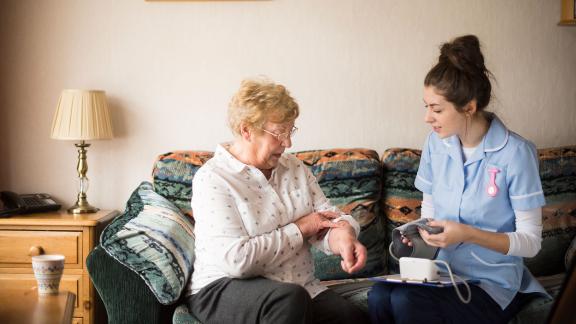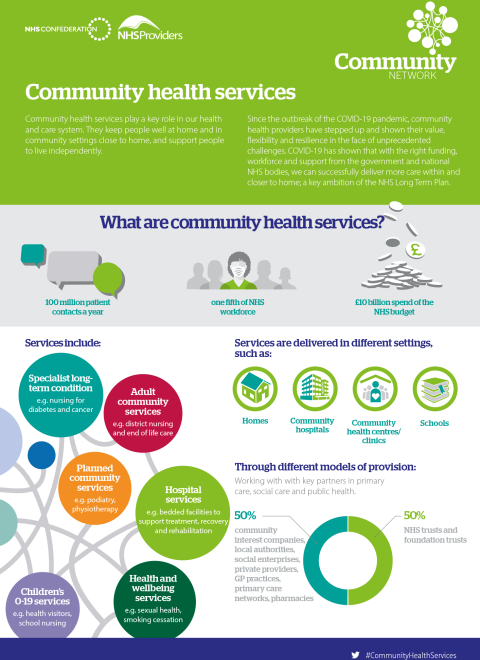Critical to care: the role of community interest companies in health and care
Key points
Community interest companies (CICs) are a unique and adaptable partner to the NHS, playing an important role in the delivery of health and care services to local communities. However, at present, they are being held back by limited understanding of their organisational form, alongside a lack of focus and appreciation at a national level of the importance of community health services.
This briefing provides an overview of their role and contribution to health and care. It is based on research and interviews with a range of CIC leaders delivering community health, mental health and primary care services.
Leaders were asked to give their views on the opportunities and challenges that CICs currently face, alongside a vision for the role CICs can play in future system transformation. This briefing captures the key issues and themes that arose and identifies the innovative ways in which CICs are delivering services.
National and local partners should consider their engagement and relationships with these organisations to ensure they are a key part of new models of care and remain at the forefront of innovative service provision.

Background
Community interest companies (CICs) are a different type of provider, occupying a unique position in the health and care ecosystem. Company structures and governance arrangements enable CICs to maximise their efficiency and productivity for wider community benefit.
CICs were established by the Companies (Audit Investigations and Community Enterprise) Act 2004 and are intended to be used by non-profit distributing enterprises providing community benefit. Crucially, CICs are a vehicle to trade, separating from them a charity. CICs do not have access to charitable funds and have to generate income through contracts for the delivery of services.
CICs were initially developed to address the lack of legal vehicle for non-charitable social enterprises across the UK. They are part of a growing social enterprise sector which covers a broad range of activity across many sectors, including health and care provision. While not charities, CICs have a strong ethical background and serve social needs, subject to controls of profits and capital.
The key distinguishing feature of CICs is the asset lock. Only 35 per cent of a CIC’s distributable profits in any one year can be paid out in private dividends to shareholders; the rest is locked in to further the CIC’s mission and vision. Indeed, reinvesting surpluses back into the community they service is written into a CIC’s purpose and aligned to the core values of the organisation.
CICs have proven to be a popular vehicle, with over 10,000 registered during the first ten years of the status being available. In 2011 the Right to Request gave NHS staff the chance to establish social enterprises, with many of the current health and care CICs set up during that period.
CICs’ role in their local communities and systems
A unique provider
CICs occupy a unique position within the NHS. They have the ability to hold both NHS and local authority commissioned contracts and operate within a diverse delivery model.
A key differential between CICs and NHS trusts is that CICs retain NHS values and deliver NHS services but do so through a commercially sustainable model that drives innovation and high levels of employee engagement.
As independent, employee-owned businesses, CICs are naturally collaborative and system-minded, with a focus on delivering services for the benefit of local populations and the wider economy. Decisions are made and ‘owned’ by members of the organisation, fostering a more inclusive and entrepreneurial approach.
Independence and flexibility
Given their independence from the NHS, CICs have greater levels of financial flexibility. This agility enables them to react to specific pressure points and help services or other parts of the local health and care system. This is evidenced by the work they do in times of extreme pressure. For example, throughout the COVID-19 pandemic, CICs provided extra capacity in the system, sending staff into local hospitals to relieve pressure and speed up discharge.
One leader we spoke to highlighted that CICs are “agile and flexible”, working in a way that is similar to a limited company, “having a degree of agility both commercially and in the decision-making process.”
Financially stable
CICs need to manage themselves in a commercial way, having a laser focus on their sustainability. A leader summarised this situation, stating “we cannot afford to overspend; we have to think about a multitude of things in advance”. Another stressed that “quite simply we cease to trade if we go into deficit… this is a reality that the NHS doesn’t have to live with [and this] makes for better financial discipline”.
With CICs’ strong focus on finance and governance, they provide contributions to contracts and the wider local health economy. However, CICs’ ability to innovate and meet increases in demand while remaining financially stable and secure is often misunderstood or not recognised.
Value driven
The leaders we interviewed emphasised that their organisations share the “exact same values as the NHS”, with the values “part of [our] DNA, mandated by standards, and we have to show reinvestment of surpluses back into our community.”
One leader we spoke to described the CIC model as a “third way” between a private entity and a state-owned entity. The same leader noted: “reinvesting surpluses back into our community is written into our purpose… we are about the place that we service, this really serves the values of the organisation”.
Community focused
CICs are nationally regulated but locally managed, existing for the benefit of the community they serve. As such, they are well placed to understand local issues and are involved the system-wide decision-making processes, with the ability to bring partners together at the level of place. CICs have an opportunity to be the “owners of locality-based work” as they are ideally placed to engage seldom heard communities and tackle health inequalities, reduce hospital admissions and bring about financial savings and efficiencies.
Interviewees highlighted that CICs are skilled at co-production; being community focused they are dynamic, responsive and quick to act. One leader outlined the difference between a CIC and providers of acute services stating that “we look at people as a whole, focusing on the wider determinants of health and the prevention agenda”. Another highlighted that CICs are focused on providing solutions to stop people needing costly, emergency, in-person treatment, whereas acute providers are “focused on diagnose, medicate and discharge”.
A level playing field?
Funding and finance
As with NHS providers, CICs have witnessed national policy ambition fail to be matched with appropriate levels of funding and resources. There remains a need to shift resources upstream, giving as much focus and resourcing to out-of-hospital care as is given to acute care, alongside an appropriate rebalancing of resources from acute to out of hospital care.
Due to their non-NHS status, CICs are currently excluded from access to capital funding, which impacts their ability to unlock the long-term investment needed to ensure they have the required infrastructure in place to meet increasing demand for services.
CICs also continue to face uncertainty regarding how the government’s pay offer to staff on Agenda for Change contracts will be funded. Non-statutory providers, such as CICs, find themselves in the situation where they pay Agenda for Change pay rates to attract and retain staff, without a commensurate increase in funding, increasing financial risk. There was a universal view from interviewees that the ongoing Agenda for Change dispute was a real threat to CICs’ ability to continue delivering services, with many organisations using financial reserves to match the settlement received by staff at NHS statutory organisations.
An equal partner
There was a feeling among leaders interviewed that CICs previously had the support of the centre, however recent decisions at a national level had made some question whether they were being treated as an equal partner. One leader noted that “increasingly we are being lumped in with the private sector, both locally and by the centre.”
In addition, a leader cited that at a national level there is a “centralised view that precludes CICs from financial investments seen by NHS trusts. However, in many cases, we are the ones delivering these services”. This was highlighted by a leader who outlined that “we are a very lean organisation, but we still have to do everything that a trust does and are measured against the very same performance metrics.”
This has led to some leaders describing the emergence of a two-tier system between NHS statutory organisations and non-statutory NHS organisations, such as CICs.
Visibility
The 2022 Health and Care Act entailed significant structural change for NHS commissioning. Integrated care boards (ICBs) have also taken on some commissioning responsibilities from NHS England, giving local systems a greater say in how budgets for these services are spent in their area.
Leaders cited that there was a feeling that CICs themselves were not speaking about the important role that they can play within systems. Another leader raised the possibility that “CICs may have gone under the radar and [are] not making enough noise about the good work that we are doing”.
Touching upon the view of CICs from the centre, one leader outlined that there was a need for CICs to agree where they “best add value within systems”. The leader went on to note that to do this requires:
- a full understanding of what CICs are and the range of services they can deliver to a local health population
- a belief that people can and want to work differently together
- a willingness to be open and honest with partners across the system.
Contracts
There remains a lack of national performance targets and quality metrics for community services. This is turn creates challenges for commissioners in comparing data between CICs and NHS organisations when procuring contracts.
CICs are also continuing to face increased pressure within a block contract framework, with the payment system disincentivising moves towards prevention and out-of-hospital care due to payment by results (PbR) rewarding acute admittance.
One leader highlighted that with CICs sitting outside the NHS’s statutory framework “[we] are not seen as an entity to contract with”. The leader gave an example of primary care networks using the CIC as a contracting vehicle, with the CIC signing contracts on behalf of PCNs.
Workforce
The supply of out-of-hospital care staff has not kept pace with increases in demand, with providers facing considerable workforce challenges in relation to recruitment and retention. The traditional routes into primary and community nursing are simply not providing the supply of staff that is needed to meet demand for services.
For example, between 2010 and 2018, the community nursing workforce has contracted by 14 per cent, with a loss of 6,000 posts.
The recently published NHS Long Term Workforce Plan outlined an ambition to grow the number and proportion of NHS staff working in mental health, primary and community care to enable more preventive and proactive care – with the plan setting out the ambition to grow these roles 73 per cent by 2036/37. Those interviewed for this piece were broadly supportive of the plan, stating that it was “crucial to underpinning the long-term sustainability of health and care system.” However, leaders questioned the benefits of the plan for CICs, noting that without additional funds to onboard new staff, “the pipeline of growth will be challenging for us.”
Alongside the ongoing Agenda for Change pay dispute, many leaders raised concerns regarding access to funding for continuing professional development (CPD) funding for staff.
The future
CICs play an important role within the local health and care ecosystem, driving people-focused services for the benefit of the local populations they serve. However, at present they are being held back by limited understanding of their organisational form, alongside a lack of focus and appreciation at a national level of the importance of community health services.
The leaders we spoke to emphasised that both nationally and locally there was a need to recognise the value that CICs bring within the health and care landscape, and without CICs “investing in the third sector there would be a big gap” in service provision. CICs need to ensure that they are a shining light of the innovative services being delivered across the health and care ecosystem.
CICs occupy a unique position as a flexible and adaptable partner to the NHS. Due to their community focus they are able to work with a range of system partners, bringing them together at the level of place to build services in local areas that deliver care closer to home.
One leader noted that CICs should “not be on the outside of the system, but also not on the inside. [We] need to have our own position within the system and we need to demonstrate what we can do and the benefits this brings to our local health population”.
Indeed, there is an opportunity to be a key part of a new model of care with resources shifting upstream with a focus on prevention. Given CICs’ knowledge of their local communities they can be both a facilitator and coordinator of place-based care and a source of innovation throughout the system. Healthy communities with be integral, with a mindset shift required to view acute care as “specialist not generalist” and “the right front door to access services where a person lives”.
Their work, providing integrated out-of-hospital care, should ensure they are at the forefront of conversations regarding system transformation – building a diverse range of provider voices with no boundaries to service delivery.




